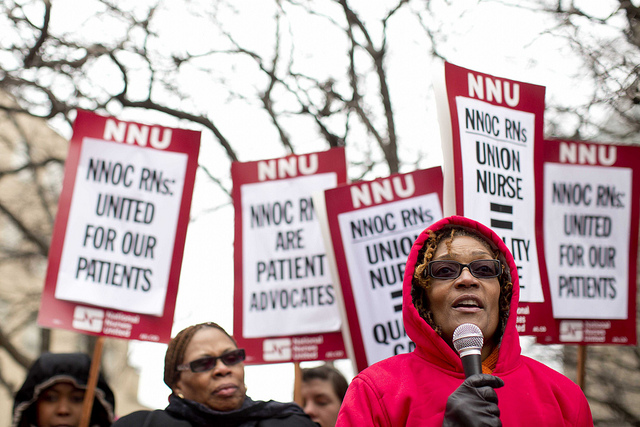Press Release
St. Louis University Hospital RNs Hold Informational Picket To Highlight Consistent Understaffing

Registered nurses at Saint Louis University Hospital (SLUH) will hold an informational picket and rally at the hospital on Monday, July 11, National Nurses Organizing Committee/National Nurses United (NNOC/NNU) announced today—to highlight unsafe staffing conditions, which are leading to the loss of experienced RNs, due to nurse burnout.
“As nurses, it’s our job to advocate for our patients,” said Amanda Sommer, RN. “It has been almost a year since SLUH was acquired from Tenet by SSM Health—a not-for-profit Catholic system with a mission statement of bringing the healing presence of God to patients. We have lost hope that change will come with the new ownership, as the hospital continues to refuse to commit to following its own staffing policy.”
What: SLUH Nurses hold informational picket and rally
Where: St. Louis University Hospital, corner of Vista and Grand, St. Louis, MO
When: Monday, July 11, 2016; 7:30 a.m. to 10 a.m. RNs say they are appealing to community and political leaders to highlight issues such as: Addressing Documented Unsafe Assignments
Nurses say they have been documenting hundreds of examples of understaffing on a form known as an Assignment Despite Objection (ADO) form. According to nurses, SLUH RNs have filed more than 425 of these forms in the past eighteen months, including more than 75 since January 1, 2016—and management has refused to accept nearly every one.
“We have documented clear examples of conditions that do not meet the hospitals own standards—and when we bring them to management, it’s as if we are asking a brick wall for help facilitating positive change,” said Paul Holland, RN. “The community can come out and see all our refused ADO forms at the picket. When we tape them together, they stretch over 500 feet. It’s an example of the distance management still needs to go to create a care environment in compliance with hospital policy. Our patients deserve better.”
Improving Staffing Ratios for Safe Patient Care
Each year, Missouri hospitals must submit a staffing plan to the Missouri Department of Health and Senior Services, outlining the hospital’s policy for providing safe patient care. When designing SLUH’s plan, nurses say, the hospital did not solicit the input of bedside RNs. It is puzzling, however, say nurses, that hospital management is unwilling to follow its own policy.
“Our patients should be receiving the highest quality care. It violates basic Catholic principles to refuse to provide what even the hospital defines as safe,” said Marchelle Vernell Bettis, RN. “If you look at the hospital’s own website, SSM Health made more than $206 million in profit last year. We know they have the resources to staff the hospital according to their policy, yet they choose not to. The hospital is unable to retain experienced nurses due to understaffing and poor working conditions that drive nurses away.”
Numerous studies have shown that strong nurse-to-patient ratios improve patient outcomes. A 2014 study published by Nursing Standard, for example, revealed that seven additional lives would be saved for every 100 Intensive Care Unit patients with improved nurse-to-patient ratios. And nurses say that, while the hospital’s existing staffing plan already falls short of what patients need—an additional issue of concern is that the hospital is not even following its own policy.
In December of 2015, the union’s Staffing Subcommittee at SLUH undertook a staffing study based on data provided by SLUH management. The study, analyzing a three-week period, determined that SLUH was understaffed—as measured against the hospital’s own safe staffing policies—58 percent of the time, across the entire hospital. Some departments, including the Intensive Care Units, where RNs often care for three critically ill patients at once, were understaffed over 75 percent of the time.
“SLUH’s patient population includes some of the poorest and most vulnerable members of the St. Louis community. The hospital also serves as a receiving facility for outlying hospitals from across Missouri,” said Kellie Allen, RN. “Our patients deserve the best possible care.”
Retaining and Recruiting Experienced Nurses In addition to impacting patient care, unsafe staffing ratios can also take a toll on RNs. A study by Aiken and colleagues, in the Journal of American Medicine, found statistically significant relationships between lower nurses-to-patient ratios and higher levels of RN dissatisfaction and burnout.
“Our nurses have reported working long hours without a single break, and having only moments for lunch,” said Brendan Gibbons, RN. “Even though the hospital has hired 176 RNs since September 1, 145 of those RNs replaced nurses who left. That’s a yearly turnover rate of around 29 percent—almost twice the national average of 16 percent. Management has the power to stop this!”
Creating a Safer Work Environment
According to the Occupational Safety and Health Administration (OSHA), 20 percent of all workplace injuries occur in healthcare environments. Forty-four percent of those injuries nationally are related to moving patients. At SLUH, 146 workers have been injured in the past four years, resulting in 2,788 days of workers with job restrictions, which impacts staffing.
“We are asking management to implement policies to protect RNs, visitors and patients from injuries, caused by workplace violence, and from exposure to infectious diseases,” said Jay Coomer, RN. “The hospital should be a safe and healing environment for everyone.”
More than 600 RNs at SLUH are represented by NNOC/NNU. National Nurses United is the largest union of registered nurses in the United States, representing more than 185,000 RNs nationwide.